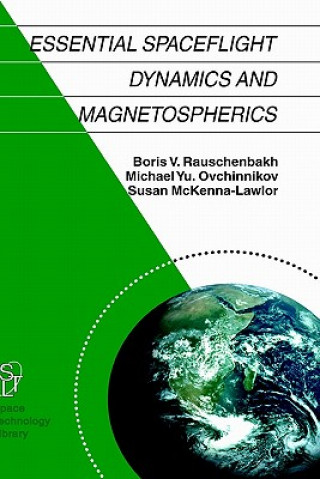
Doručenie
Nákupný poradca





Nehodí sa? Žiadny problém! U nás môžete do 30 dní vrátiť
 Darčekový poukaz
v ľubovoľnej hodnote
Darčekový poukaz
v ľubovoľnej hodnote
S darčekovým poukazom nešliapnete vedľa. Obdarovaný si za darčekový poukaz môže vybrať čokoľvek z našej ponuky.
Essential Spaceflight Dynamics and Magnetospherics
 Angličtina
Angličtina
 685 b
685 b
30 dní na vrátenie tovaru
Mohlo by vás tiež zaujímať


Essential Spaceflight Dynamics and Magnetospherics describes, in the first instance, some of the key aspects of celestial mechanics and spaceflight dynamics. It begins with classical two and three body problems illustrative of the aesthetic aspects of applying analytical methods of investigation to celestial mechanics. Then, osculating orbital elements are introduced as well as analysis techniques sufficient to evaluate the influence of various disturbing forces on spacecraft. Next a theory of manoeuvres is outlined and the methodology of making interplanetary trajectory corrections. Ideas involving various approaches to orbital element determinations using measured data are also considered. The forces applied to a spacecraft can result in the development of torques that influence attitude motion and the effects of the most important of these are described in terms of equilibrium positions, periodic motions, steady-state and transient motions. Also considered is the problem of attitude control of a spacecraft using active and/or passive methods of orientation and stabilization. In addition, a more advanced treatment of the development of attitude control systems is provided. The present book Essential Spaceflight Dynamics and Magnetospherics describes, in the first instance, some of the key aspects of celestial mechanics and spaceflight dynamics. It begins with classical two and three body problems illustrative of the aesthetic aspects of applying analytical methods of investigation to celestial mechanics. Then, osculating orbital elements are introduced as well as analysis techniques sufficient to evaluate the influence of various disturbing forces on spacecraft. Next a theory of manoeuvres is outlined and the methodology of making interplanetary trajectory corrections. Ideas involving various approaches to orbital element determinations using measured data are also considered. The forces applied to a spacecraft can result in the development of torques that influence attitude motion and the effects of the most important of these are described in terms of equilibrium positions, periodic motions, steady-state and transient motions. Also considered is the problem of attitude control of a spacecraft using active and/or passive methods of orientation and stabilization. In addition, a more advanced treatment of the development of attitude control systems is provided. A description of the Earth's magnetic and gravitational fields allows clarification of the relationship between natural features of the Earth's environment and the requirements of mission design, orbit construction and approaches to attitude control. A detailed Addendum provides an overview of circumstances on the Sun that render interplanetary space a very hazardous environment for spacecraft and for `man in space'. The influence of this environment on spacecraft performance and survival is then presented, together with an outline of some of the mitigating strategies that can be invoked. A feature of the Addendum is the indication it provides of the challenges that the next generation of space experiments will pose to mission designers. It is accompanied by a separate set of references since if refers to ongoing work in space physics rather than to classical material.
Informácie o knihe
 Angličtina
Angličtina
Kategórie




 Ako nakupovať
Ako nakupovať



























